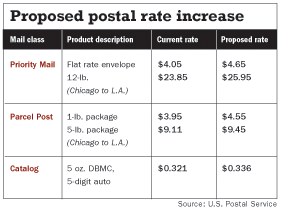The postal rate case proposed on May 3 calls for an average rate increase of about 8.5%. But unlike the postage increases implemented this past January, which were pretty much a flat 5.4% across the board, the new rate case is much more variable. The proposed increase for Standard Mail is about 9%, for instance, while Priority Mail rates will go up an average of 13.8%, Express Mail an average of 12.5%, and package services an average of 13.4%. If approved on schedule by the Postal Rate Commission (PRC), the hikes would take effect in mid-2007.
Further complicating matters is that the U.S. Postal Service intends to change how it calculates rates. The current pricing structure is primarily based on weight; the proposed plan uses shape along with weight to determine pricing. The rationale is that this allows the USPS to better align prices with processing costs.
Shape vs. weight

“If you don’t mail a [standard-size] flat, you will be facing higher rates,” says Bob McLean, executive director of the Arlington, VA-based Mailers Council. “The Postal Service has spent millions in improving the processing system for flats, and it believes in using equipment instead of manpower when possible.” In short, he says, the USPS is interested in changing more than just the rates; it’s trying to get mailers to change what they mail — more pieces that fit neatly with the parameters of its machinery and fewer pieces with irregular shapes (square rather than rectangular, for instance) and trim sizes (higher than 12″, say, or narrower than 6″).
But according to Jerry Cerasale, senior vice president of government affairs for the Direct Marketing Association, downsizing from a flat to letter size will provide less of a discount under the proposed rates than under the current rates. By the same token, increasing or decreasing the weight of your catalog won’t yield as much of an increase or decrease in postage under the proposed rates as under the current rates — but Cerasale hastens to add that weight will remain a factor.
Because of the complexity of the proposed changes, however, not everyone agrees on how much of a factor, and to whom. For instance, Don Landis, vice president of postal affairs for Menomonee Falls, WI-based printer Arandell Corp., says that catalogers whose books weigh 3.3 oz. or less will be hit with higher rate increases than those mailing heavier catalogs. The average catalog, he continues, weighs 3 oz.
In fact, Landis believes that most catalogers will be paying more than the 9% increase that the USPS says is the average rate hike for Standard Mail. “You’re going to see a larger increase than that in catalogs, about 14%,” Landis says. “What little we’ve looked at, it looks like some of the lesser weights would see a double-digit increase, compared to heavier weights. The lesser weights with no drop-shipping could definitely see a double-digit increase.”
Sharing the work
Drop-shipping deeper into the postal stream — sorting and delivering catalogs into destination delivery units (DDUs), which are the individual post offices, rather than into the bulk mail centers (BMCs), for instance — and other types of worksharing will also play a greater role in determining your final postage rates under the proposed changes.
For instance, currently a 4-oz. rigid automation flat that enters the mail stream at the destination sectional facility (DSCF) level currently costs $0.275; if the rate case is passed, it will cost $0.491. But if you switch to flexible packaging for improved automation, the proposed cost would be $0.291.
All these variables mean that mailers and their vendors will need to get busy calculating which combination of modifications will save them the most money, taking into account additional expenses (hiring a postal consolidator to drop-ship your catalogs, for example) that making the changes could incur.
But they can’t get too busy yet, because not all the necessary information is available, Landis says. “We may soon have to redefine what is automatable. And in the presort level we don’t know exactly where our pieces are going to fall.”
Currently there are five sortation levels, but the proposed rate case calls for nine sortation levels. The 3/5-digit sortation level, for instance, would be eliminated and replaced with a 3-digit level and a 5-digit level. The per-piece rate for an automated flat weighing no more than 3.3 oz. with no entry discount is currently $0.275. The proposed rate for the same flat sorted to the 3-digit level is $0.328; to the 5-digit level, $0.300.
“Where those five [levels] fit into the nine could make a difference,” says Landis. Until definitions of automatable pieces are obtained, he says, it’s difficult to say how those pieces will be sorted in the tier sortation process. “We’re still analyzing the proposal, and we’re still waiting for more information from the Postal Rate Commission.”
The PRC set May 31 as the deadline “for interventions, answers to motion for waiver, and for protective conditions” regarding the case. The deadline for statements regarding topics for the prehearing conference is June 7, with the prehearing conference slated to begin June 14.
